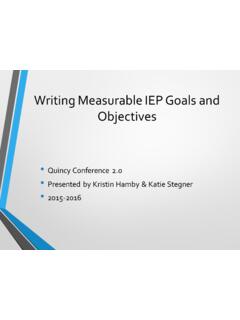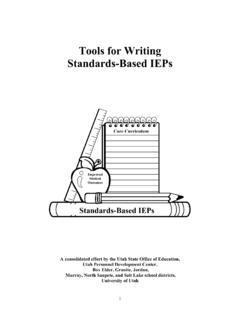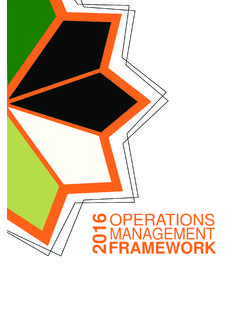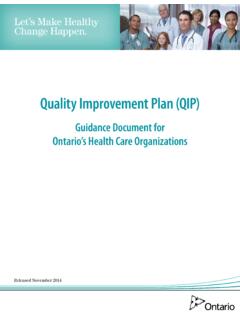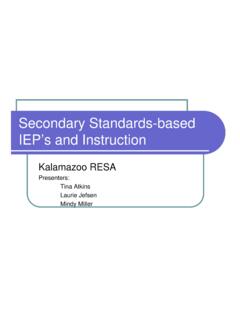Transcription of Writing Measurable IEP Goals and Objectives
1 Writing Measurable IEP Goals and Objectives Quincy Conference Presented by Kristin Hamby & Katie Stegner 2015-2016 SMART Goals & AchievableRealistic & RelevantTime LimitedStandardsGoals and Objectives34 CFR (a)(2)(i)(A-B) Annual Goals Directly related to PLAAFP Goal-statement of what the child will demonstrate or learn within the next 12 months Written in objective and Measurable terms Avoid vague terminology Progress report yearly on Objective/Benchmarks-break down the goal in smaller more Measurable parts. Monitor student progress in intervals Steps along the way to accomplish the overall goal Report progress quarterly They should directly relate to achieving the overall of a Goal An overall goal should answer the following 6 questions: WHO?
2 DOES WHAT? WHEN? GIVEN WHAT CONDITIONS? HOW MUCH? HOW WILL IT BE MEASURED? By answering these questions, you are ensuring that you have a complete and Measurable and Does What WHO: The student Use the student s name DOES WHAT: The observable behavior Describe the observablebehavior using action words. Write, list, identify, label, state, define, summarize, explain, retell, paraphrase, illustrate, compare, contrast, use, apply, solve, predict,Mary will orally retellat least 5 major events from a text at a 2ndgrade level after she has silently read the or Wrong Kevin will solve 5 one digit addition problemsOR Kevin will be able to solve 5 one digit addition problemsNon-MeasurableStatementsMeasurab le Statements Shows anger Is cooperative Will understand math concepts Increase ability to read Demonstrate understanding of counting Shows anger by hitting,kicking.
3 Punching others Is cooperative by following the teachers directions with less than 1 prompt within 20 seconds Will understand math concepts by solving a mixture of addition and subtract 1D+1D or 1D-1D Increase ability to read by reading a level D with 95% accuracy, SC rate 1:3, comprehension score of 5/7 Demonstrate understandingof counting by rote counting orally from 1-100. Does What Comparisons When? Required in the annual goal, but optional in your Objectives . Annual Goal: required By January 3rdof By the end of the current IEP By 1/3 Objectives : optional end of the 1stquarter During the 2ndquarter During the 2ndsemester Upon meeting objective a, b.
4 Given What Conditions and CircumstancesCould Include: Instructional cues Supports the student needs Grade level materials Settings/Environm ental Factors Time of dayConditions may start with phrases such as: From the _____ (text, material, ) When provided While in a group of two or more other WhatUnder What conditions and circumstances Given a 3rd grade level reading With the use of a When provided with text on Given ten 2nd grade level word During transition When asked a direct question by a staff member that requires a Given grade-level 2-step word problems involving all operations (+, -, X, ) and whole numbers (read aloud if needed)
5 Given a persuasive or narrative Writing prompt and a blank pre-made graphic organizer, In classroom settings when a teacher asks the if he needs assistance or redirects him back on task, After reading a text on a 1stgrade Avoid stating specific curriculumsHow Much Must have criteria for mastery in your overall goal. Objectives : Can listed in the objective statement, but must be selected choice boxes in Outreach. Describe the performance accuracy of the action need for the goal or short term objective to be considered completed. Assume this is at 100% unless otherwise stated. Objectives -state the lesser value for the first objective and gradually increase % for sequentially based Much?
6 Criterion for Mastery Make the criteria appropriate to the behavior you are measuring. Level of performance in which the goal will be achieved. Percentages/Accuracy Number Correct Trials _____ out of ____trials Rate Frequency # of attempts Fluency Time to respond within _____ minutes/seconds Level of prompting (full physical, vs. partial physical, vs, verbal, vs. independent) Duration Quality ratings (scores on scales/rubrics) Number or words/paragraphs writtenAdditional Criterion for Mastery Could Include: Generalization-Additional conditions under which a behavior will occur. With different people Various environments Varied instructional cues Across times of dayEXAMPLE: Given a teacher prompt to count from 1-100, Mary will orally count from 1-100 independently with 95% accuracy in the resource classroom and in her general education Criterion for Mastery Could Include: Maintenance-perform the task to criterion for a specified period of time.
7 EXAMPLE: Given a teacher prompt to count from 1-100, Mary will orally count from 1-100 with the use of a number grid as a visual reminder in the resource classroom and in her general education classroom with no errors 3/3 trials for three consecutive Procedure Progress Monitoring Be intentional when selecting evaluation procedure Possible evaluation procedures observation logs data charts/ graphs tests work samples collected rating scales running records checklist rubrics CICO-ODR Writing Proficiency daily or weekly trials-+/-listed ABC assessment EASY-CBM phonics assessments phonemic awareness assessments teacher made checklist or testIEP
8 Writing GoalWho: _____Does What: _____When: _____Given What: _____How Much: _____How will it be Measured: _____Kim will decode words while reading with 80% accuracy by 1/5 : Goal Mark will increase his ability to solve addition, subtraction, time, and money problems as specific and measured by the short term Objectives . Objectives Mark will solve addition problems. Mark will solve subtraction problems Mark will tell time to the quarter hour. Mark will count and ID all Bank Resource for ideas Should not click and choose Change to an objective answering the Wh questions outlinedOutreach Objective BankWhen visually shown 26 upper and lowercase letters in isolation (one letter), Mary will name the letter and the sound 2/3 trials with 100% given up to 5 pictures and 5 letters (corresponding sounds/picture)
9 , Mary will match the letter and the picture that represents that sound with all 26 letters 2/3 trials with 100% given up to 10 lowercase and 10 uppercase magnetic letters on each trial and asked to match upper and lowercase letters, Mary will match the uppercase and lowercase letters in pairs with all 26 letters 2/3 trials with 100% Information about Objectives Objectives can be written in a variety of ways Component based Sequentially Reduced prompting level Increasing accuracy or trialsLearning Disability Eligibility Areas Reading Basic Reading Fluency Comprehension Written Expression Math Mathematical Problem Solving Math Calculation Oral ExpressionIt is not mandated that a separate goal page be written for each area of eligibility with math and reading if the student is found eligible.
10 But it is often difficult to cover each area under one goal. Best practice would be to address each deficit area in a Level Example #1 MollyMolly is a 5thgrade student with an eligibility of Specific Learning Disability-Basic Reading, Fluency, Comprehension. Present Level for Fluency-When assessing Molly s fluency rate on the most recent evaluation, she was able to read a forth grade passage with 85% accuracy and a rate of words per minute and a 5th grade passage at 51 w/m with 83% accuracy. The fifth grade results placed her at the 5th percentile when comparing her to students of the same age range. Note: The average forth grade student would read approximately 88-131 words per minute in the to score at the average range.
